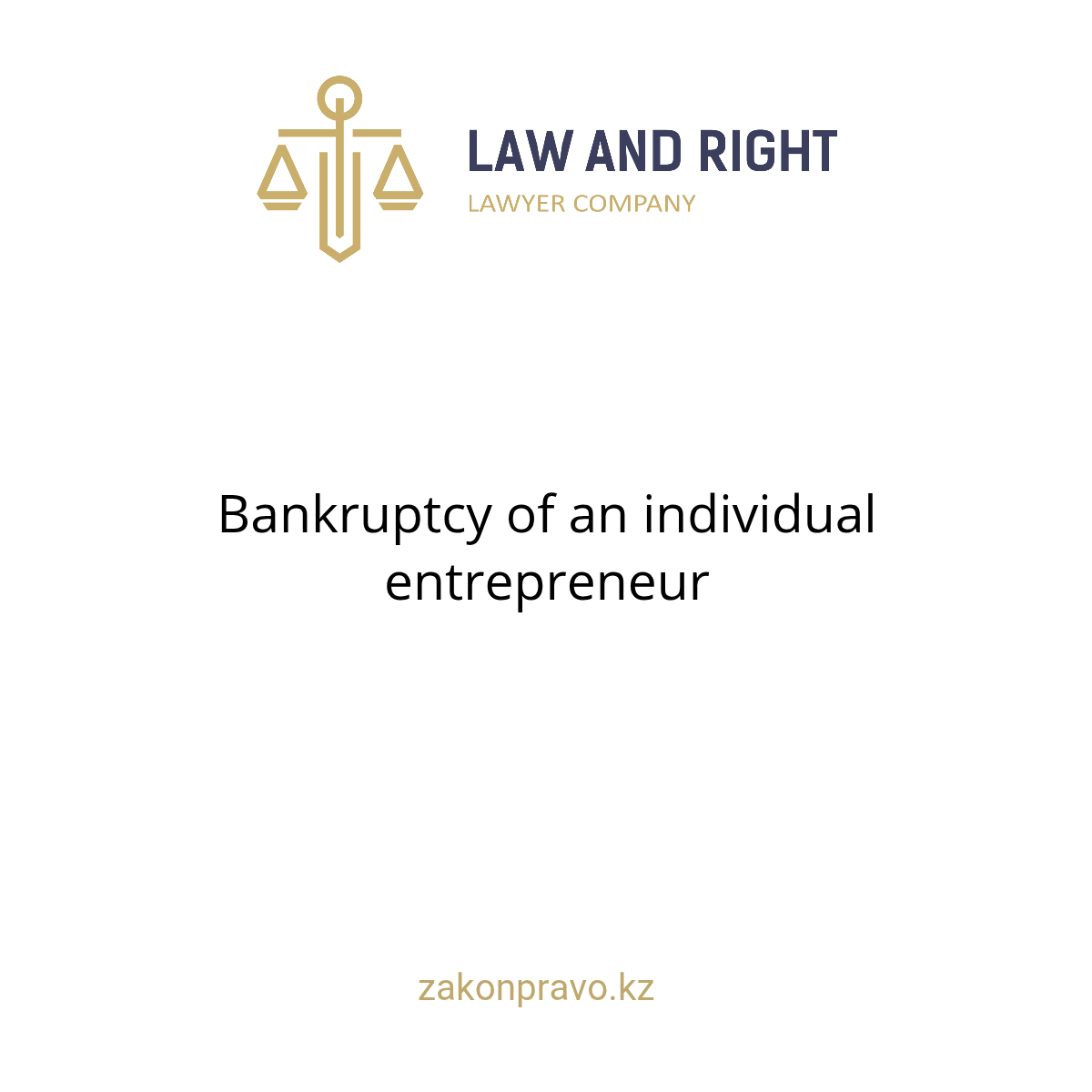Bankruptcy of an individual entrepreneur
🔷 I. GENERAL PROVISION
Article 21 of the Civil Code of the Republic of Kazakhstan (RK) establishes a special legal regime for the bankruptcy of an individual entrepreneur (IE) as a subject of civil legal relations. This mechanism is governed by the Legislation on Rehabilitation and Bankruptcy, including:
📚 The Law of the Republic of Kazakhstan dated March 7, 2014 No. 176-V “On Rehabilitation and Bankruptcy” (hereinafter — Bankruptcy Law).
🔹 II. GROUNDS FOR BANKRUPTCY — INSOLVENCY (Clause 1)
“Insolvency of an individual entrepreneur… is the basis for declaring them bankrupt.”
🔸 Insolvency (Article 52 of the Civil Code) is the inability of an IE over a certain period to fulfill their monetary obligations to creditors and mandatory payments.
📌 Criteria for insolvency:
- Payment delays of more than 3 months;
- Insufficient assets to cover debts;
- Termination of business activity.
📚 See also:
- Article 52 of the Civil Code — definition of insolvency;
- Article 3 of the Bankruptcy Law — criteria for IE bankruptcy.
🔹 III. FORMS OF IE BANKRUPTCY (Clause 2)
“Bankruptcy may be declared voluntarily or compulsorily...”
🔹 Voluntary bankruptcy: The IE files a petition in court, recognizing their own insolvency.
🔹 Compulsory bankruptcy: A creditor files the petition if the IE refuses to fulfill obligations.
📌 The case is reviewed by a district (city) court at the place of residence of the IE.
📌 Consequence: After completion of the bankruptcy procedure, the court issues a ruling that:
- Closes the case;
- Leads to cancellation of the IE’s registration.
📚 Related provisions:
- Article 53 of the Civil Code — termination of business activity;
- Article 54 of the Bankruptcy Law — consequences of bankruptcy completion.
🔹 IV. CLAIMS OF NON-BUSINESS CREDITORS (Clause 3)
“Creditors for obligations not related to entrepreneurial activity… also have the right to file their claims...”
🔸 This is an important feature of IE bankruptcy:
- All creditors are allowed in bankruptcy proceedings, including those with personal claims (e.g., alimony, loans, damages in a traffic accident).
🔸 However:
- If such claims are not submitted during bankruptcy, they retain legal force and can be presented after the procedure, but against the individual (not the IE);
- The claim amount is reduced by the amount recovered during bankruptcy.
📌 Example: If an IE owes office rent (a business debt) and also has a personal loan from a friend (a personal debt), and only the landlord files during the bankruptcy, the friend can still collect after bankruptcy — but only for the unpaid portion.
📚 See also:
- Articles 49–50 of the Bankruptcy Law — creditor claims procedure.
🔷 V. RELATED NORMS
| Provision | Content |
|---|---|
| Civil Code RK, Art. 19 | Individual entrepreneur |
| Civil Code RK, Art. 52 | Insolvency |
| Civil Procedure Code RK, Art. 37 | Liability of an IE for obligations |
| Bankruptcy Law, Arts. 54–61 | Effects of the completion of bankruptcy |
| Civil Procedure Code RK, Chapter 27 | Bankruptcy case proceedings |
🔷 VI. JUDICIAL PRACTICE
🔹 Example 1: An IE filed for voluntary bankruptcy, submitting documents proving debts and lack of assets. The court declared bankruptcy and canceled the IE registration.
🔹 Example 2: A creditor submitted a claim against an IE after the bankruptcy procedure. The court partially upheld the claim, stating that the debt had not been included in the procedure but should be reduced by the amount covered during the bankruptcy.
🔷 VII. INTERNATIONAL STANDARDS
| Instrument | Content |
|---|---|
| UNCITRAL Legislative Guide on Insolvency Law (2005) | Principles on bankruptcy of small business entities |
| OECD Recommendations on SME Insolvency (2020) | Support for business restart after bankruptcy |
| Constitution of the RK, Article 26 | Right to entrepreneurship, property protection |
| UN ICCPR, Article 11 | Prohibition of imprisonment for failure to pay civil debts |
🔷 VIII. CONCLUSION
Article 21 of the Civil Code of the RK:
- Ensures that individual entrepreneurs are subject to bankruptcy procedures similarly to legal entities;
- Protects both business and non-business creditors;
- Clearly separates property consequences before and after bankruptcy.
It works in close conjunction with the Bankruptcy Law, forming an effective legal tool to restore economic balance between the debtor and creditors.
Attention!
Law and Law Law Law draws your attention to the fact that this document is basic and does not always meet the requirements of a particular situation. Our lawyers are ready to assist you in legal advice, drawing up any legal document suitable for your situation.
For more information, please contact a Lawyer / Attorney by phone: +7 (708) 971-78-58; +7 (700) 978 5755, +7 (700) 978 5085.
Attorney at Law Almaty Lawyer Legal Services Legal Advice Civil Criminal Administrative Cases Disputes Protection Arbitration Law Firm Kazakhstan Law Office Court Cases


